#reddit makes me viscerally angry sometimes
Explore tagged Tumblr posts
Text
New least favorite misconception about Cassandra Cain is that she doesn't kill because she would upset Bruce when she literally chose not to kill herself because she's fundamentally a good person, not because anyone, especially not Bruce, taught her it was wrong.
266 notes
·
View notes
Text
Game Dev Update | 4.28.17

“You ate the last Twinkie...” - Master Dwarf Thisguy ^
We’ve waited to show more than a glimpse of the dwarven race on Embermark until our own hammers were pounding out the mass of loot we’ve promised in Dev Updates past. Now that the promised loot train is rolling, it’s time to really take a look at our stout, grumpy friends.
Last update, we covered the beginning of our game mode experimentation, world map navigation, a Legendary sword and the ability to view your Battle History. This time, its about content and gameplay. Read on to check out our new icon system, new battle environments, new loot, an upcoming AMA, your chance to help design an item that ends up in the game and what we’re learning about battle mechanics.
Oh, and dwarves.
DWARVES
Whether they’re holed up in the caverns and carved-out tunnels of Siege or feverishly rebuilding the once-great Anglon, dwarves in Embermark are a force to be reckoned with. Here’s an Elite version of our angry fellow from above:
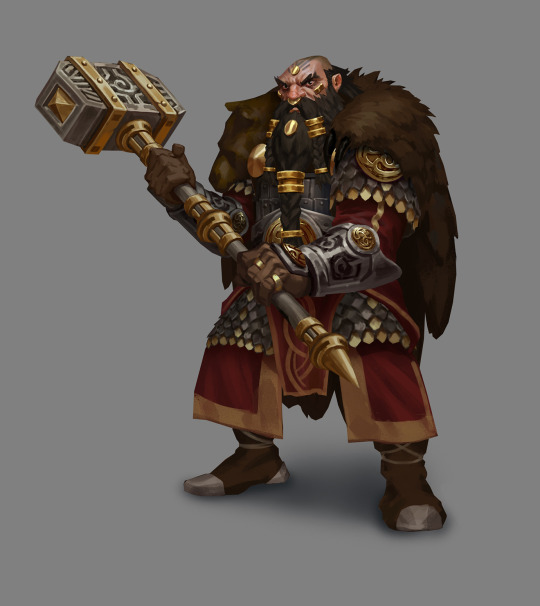
We started the dwarf-creation process exploring what we wanted the basic proportions, faces and gear types to be, as well as where they reside in Embermark and what their background is. As you can see below, Beardbo Grumperson IV there on the far right is a look we’ve stuck with through the representation of our Elite fellow above.
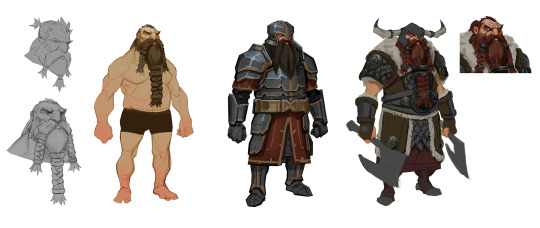
There are a few geographic locations where the dwarves in Embermark tend to be found (though they travel and team up a bit more than dwarves in many other settings), and as mentioned before, the region of Siege is one of them. They’ve gone underground for the past several hundred years as Embermark was overrun and a terrible place to live, but a few ancient entrances to their underground lairs are still visible on the world map:
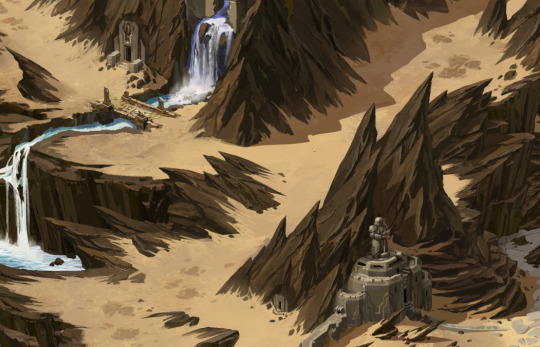
3D design proceeded much as all the humanoid races we’re developing have-- from the base player model, with some changes that led into a distinctly dwarven look:
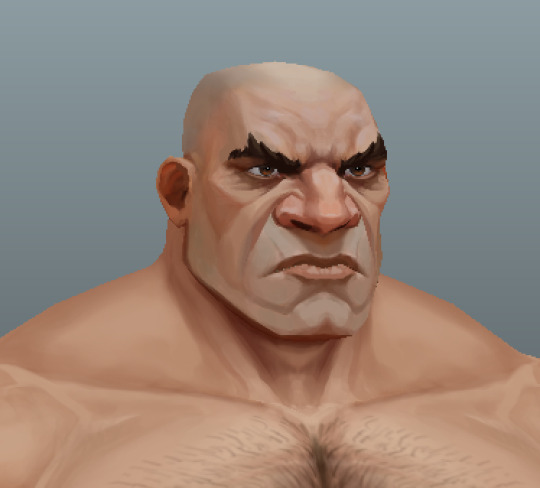
And unless the dwarf in question has been beaten in battle to a humiliating degree lately, he/she usually has some manner of facial style going on:

We couldn’t resist this one:
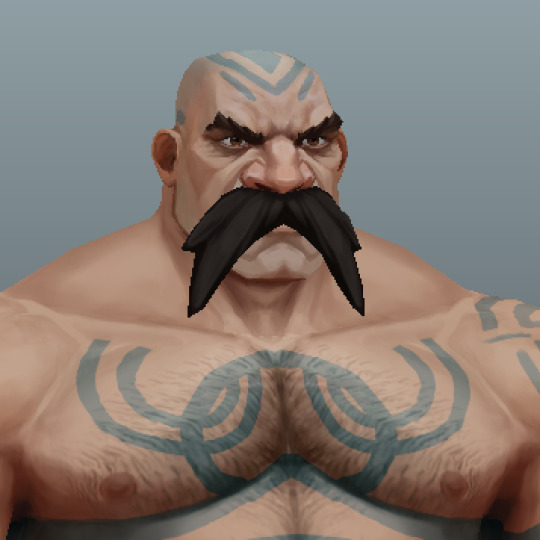
And this one, with a better look at some of the tattoo designs we’re playing with:
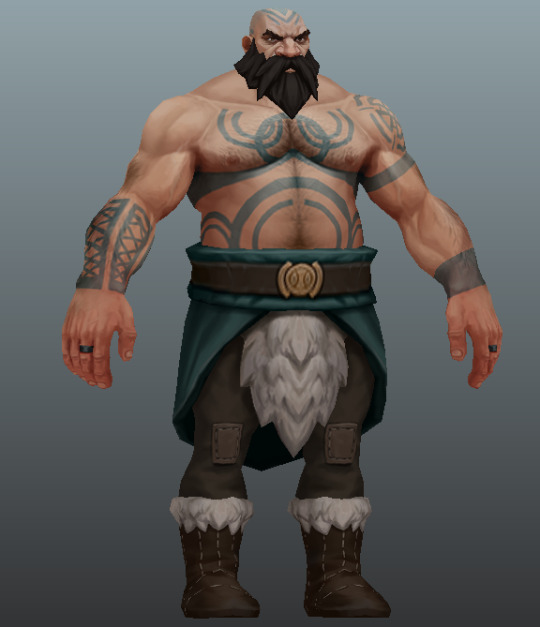
I’ve mentioned the history and background of the wolves in Embermark before (despite my bold-face lie about there being no rats, bats, wolves or skeletons in this game). They’re a mean and cunning lot, with far more organization to a “pack” than typical.
Well, this gives you a clue about how dwarves on the continent feel about them:

Depending on the proportions of our humanoid NPCs, we’re making versions of all their gear to also fit the player, for extra tasty drops.

ICONS
When you have a lot of lootses in a RPG, someone has to make the icons. And usually, artists hate doing it cuz there’s so many and it takes so long and it’s not sexy.
WRONG.
With Exiles, it is sexy (and so are you). We’ve had the same placeholder sword/boot/pants icons in just about every screenshot you’ve seen up till now (like here and here). No more!
Because we aren’t satisfied with that (and hate sleep), we created a new icon creation pipeline that takes EACH design for a piece of loot and creates an icon for it. So for every item you get, you’ll see a Tier 3 (that’s the highest) image of that item over a rarity color (either nothing, blue, purple, gold, or green) to give your loadout that extra oomph you’ve been looking for.
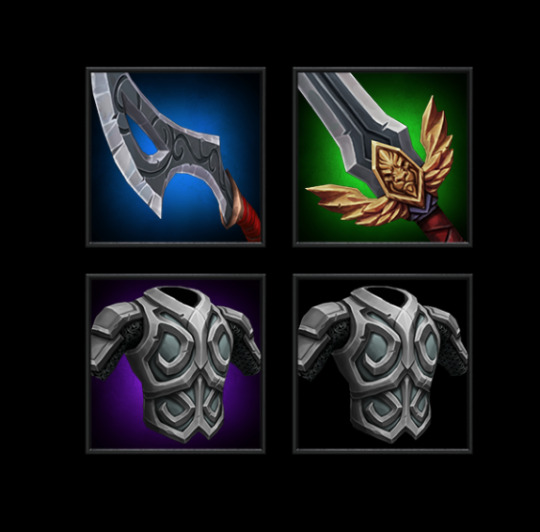
GAME MODE EXPERIMENTS
As fast as the content train is moving, the mechanics train is hurtling along just as fast. Now that we have most of the Abilities, Stats and Talents working for the Warrior and Mage classes, we’re diving into what will make the moment-to-moment gameplay the most strategic, satisfying... and visceral! To that end, we have our 4-Ability loadout that we’ve talked a lot about, but last week, we got a second mode of combat going-- The Deck.
With The Deck, the rules of the game are still the same:
WEGO-style turn-based with initiative determining order of ability execution
Abilities combine with Gear & Talents to create effects on either character
First character to die (there’s no fainting in Exiles) loses
However, instead of a 4-Ability Set, you now choose 8. 4 are chosen for you randomly at the beginning of a Battle and the others are in queue. As you use Abilities, they cycle back into the deck and the next Ability in the deck becomes available (see the smaller “coming” Ability represented below-- that is WIP as is everything in these Updates, and it will get a proper UI representation if it ends up being something we support).

Initial testing has proven fun and maddening-- my main Mage “MoarMagicks”still can’t consistently beat SingmeAsong’s main Warrior “Jackal,” despite my clearly superior strategies and build-- and we have some work to do on what the mode does to overall balance. But it’s promising, and we’re excited to show it to you if it ends up passing muster.
AMA
We’re getting ready to do another AMA! If you’ve got burning questions about Exiles, from features to rules to lore to whatever, join the crew and the community for an evening of anything goes-- even making fun of the devs-- we can take it. Submit questions/discussions now on the Reddit thread, and we’ll have some answers ready. And you can win stuff! We’ll be doing some good old-fashioned rolling (of virtual dice) for in-game prizes (loot table is forthcoming, and will be published on the AMA thread in the forums).
So head over to the Discord channel on MAY 9 at 5:30 PM Central Time and get the inside scoop on all things Exiles.
WE HAVE AN ANDROID BUILD
“WHAT?!”
Yes. MANY of our early testing sign-ups have Android devices, and I have some good news for them-- we have an early Android build! Now, before any shenanigans break out, you should know that it’s rough, new and not as far along as the iOS build. But it lives, and you Android users will be kicking arses before too long right beside your iOS brethren.
VANISIR
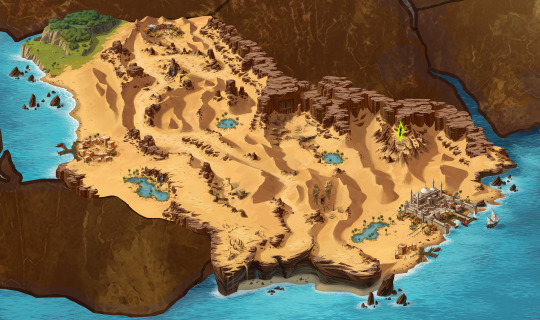
Along the southwest of Embermark is a region called Vanisir, a mostly arid-- but critical-- piece of land, given its major port, resources and the presence of a manageable Breach. We’re rolling out Battle environments for each of our starting world zones, and Vanisir’s first can be seen here, with an unfortunate player sizing up the enemy that I can’t stop showing to you-- the overly intelligent and vicious WOLF.
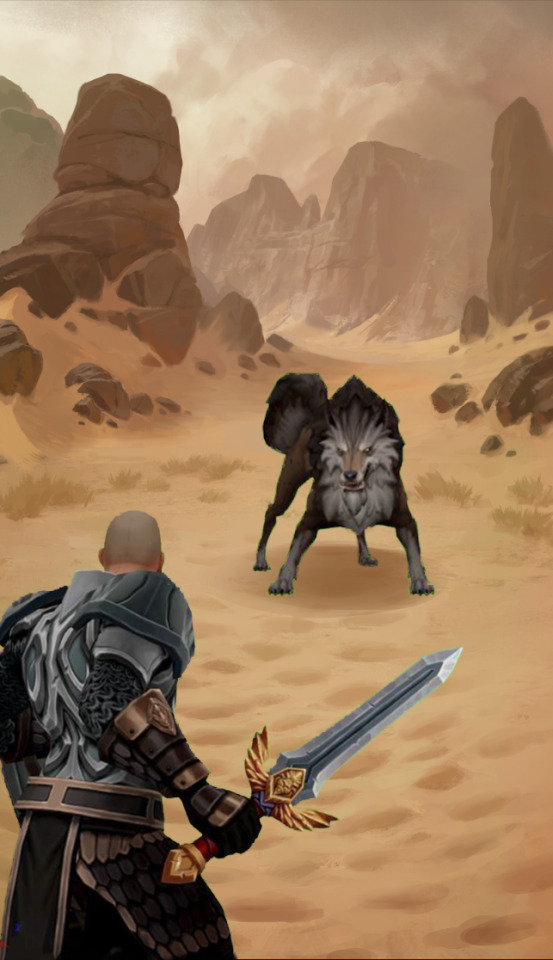
“Hey, didn’t I just see you atop some dwarven shoulder armor?”
THE PLAYER CREATED GEAR CONTEST (PCGC)
Players have been guiding us every step of the way toward Embermark and it’s time for them to get a piece of loot or two (or more) in the game. All of the rules surrounding battle and loot haven’t been revealed, but those of you following the development of the game probably have an idea or two rolling around in your heads about a piece of equipment that would do X, Y, or Z.
So the 1st Exiles Player Created Gear Contest (PCGC) is on! Check this thread in the forums for all the details and how to submit your idea. One lucky (and clever, and creative) winner will get their piece of loot in the game (and get a copy of it themselves) and many will win prizes based on the criteria you see in the official thread!
LOOT UPDATE
The loot train continues, and our artists are feverishly designing, modeling texturing and lootzing armor weapons and even rings now (rings are just icons, so they won’t show up on your person, but whatevs).

Armor for the Warrior is getting the color-tell treatment, as we showed for the Mage armor earlier. You’ll see it throughout the system as you start to play, and it’s turning out to be both useful and sometimes hilarious, depending on the how close your gear build preferences are to your color preferences (did someone say transmog? *whistles as he walks away).
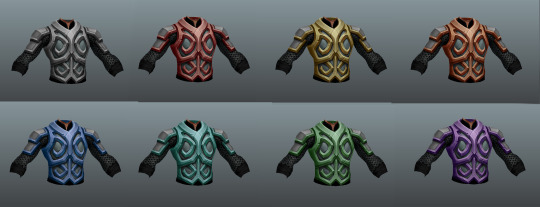
Behold the Axe of Cleaving (your head from your body)!
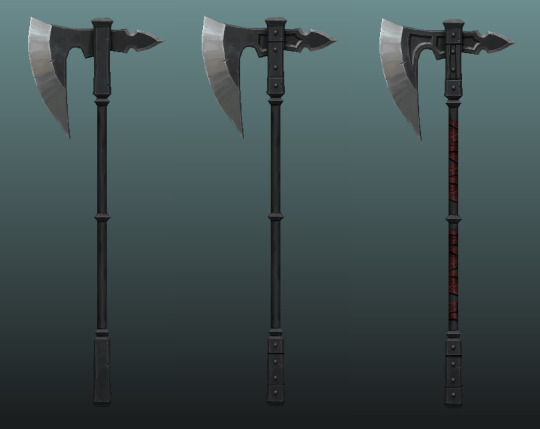
You will see this spear put to good use by our draconian friend below.
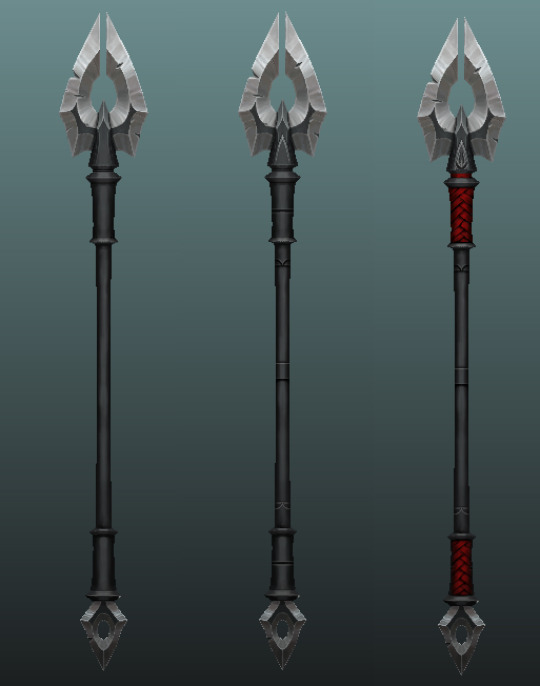
I’m not even sure what to say here other than I wouldn’t want it connecting with any part of me...
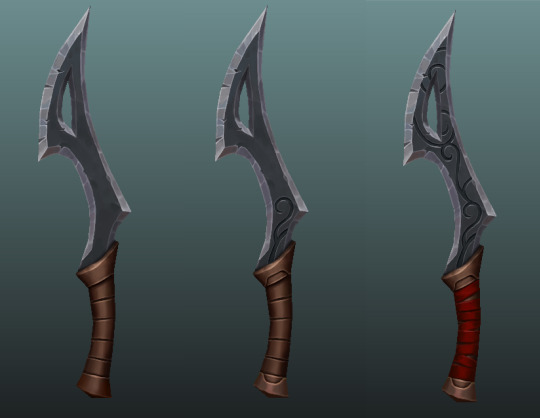
We continue to design various silhouettes for shields, for those sword-and-board enthusiasts out there...
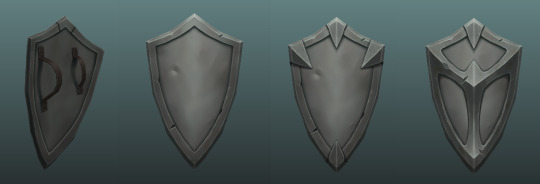
And here’s one more! (this one’s a stock broadsword, but I still lurve it)
MILITARY
Last couple of Updates, we’ve been showing off a race of baddies that will hound and hinder you throughout your journey to be among the Marked. Their political and military machinations threaten to overrun the entirety of Embermark.
They also look like dragons, have wings and are awesome. Now we’ve got them animating in the engine and will be playable in short order. Like the dwarf above, we created their gear with an eye towards dropping it for you to use in your own loadouts.
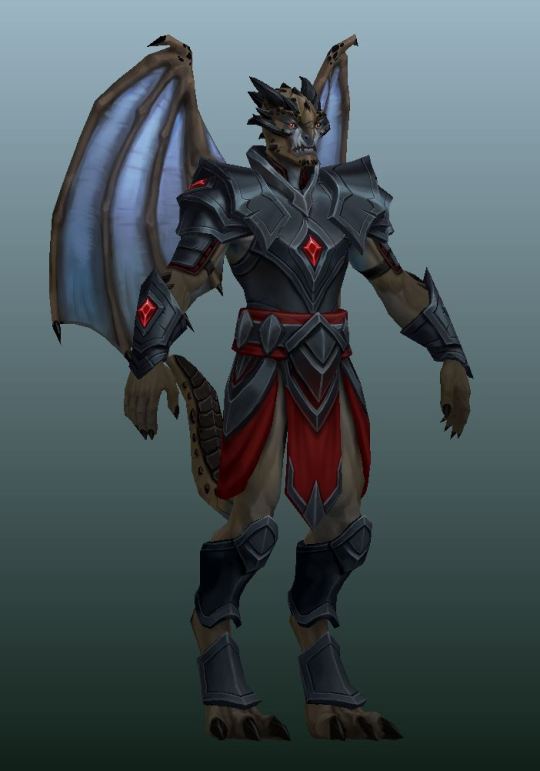

(Alas, I had to fool with this one quite a bit to get it under Tumblr’s 2 MB GIF limit, so if you want a higher quality look at this attack, it’s here)
REMEMBER
We’ll keep sharing details as we head into testing (remember to PM TheWizard on the Exiles forums if you want in on closed testing & beta later), and you can count on early impressions from the testers throughout our various channels.
If you haven’t already, follow along with the Exiles development on Twitter, Instagram and Facebook. And if you haven’t, I’ll find you. And SMITE you.
GET IN ON THE CHATTER
If you want to hear about the game, ask questions or connect with others who are helping the development team think about features, design and narrative, hop into the Discord Channel for live chat and say hi– it’s a friendly lot with plenty of daily shenanigans (there’s even a Shenaniganizer).
THE BONUS
I leave this here without comment.

3 notes
·
View notes
Text
Safety as Risk Management
A few months ago, I posted an article on why I use Safety Tools. It was met with some mixed criticism and there were a number of respectful objectors with whom I engaged in a back and forth dialog about their perceptions of how safety tools are used at the table. What I learned was that there was a misconception — that some people believed that using safety tools was to dilute the content of your game; taking away elements that your average player enjoyed (e.g. violence), while others thought that there was no need for tools if you can just “talk it out”. So today, I am going to follow up my article to address some of those misconceptions as well as to try to explain safety by drawing in some other areas of my life.
The Goal is to Play Harder AND Safer
I have played a lot of games in the decades I have been in this hobby, and I have murdered my share of orcs and goblins, robbed crime lords, attacked space pirates, etc. I have had most of the standard RPG experiences that we all think about when we think about this hobby — most of those occurring before the hobby even began to explore the idea of safety.
But I also like another kind of RPGs, ones that have deep emotional connections, ones where my pregnant widowed French Revolutionary is executed outside of Paris while trying to escape a siege, where my character gets into a heated argument with their partner about what kinds of sex are intimate and not, and where my teenage vampire’s sexuality is challenged. I like games with charged emotional content, and often with content that I am unsure how I am going to feel about during play.
And the thing is, I don’t want to have to use the safety tools I have put out, and I don’t want to water my games down or remove charged content. Quite the opposite, I want MORE of that.
Share5
Tweet5
+11
Reddit1
Email
And the thing is, I don’t want to have to use the safety tools I have put out, and I don’t want to water my games down or remove charged content. Quite the opposite, I want MORE of that. The safety tools are like a Safe Word, in Kink terms (a future Safety article). I want my more intense play to take me up to the edge, to where I am uncomfortable but still safe. The tool is there so that in case any of us miss the mark and we go too far, we can signal that to everyone else.
So when I sit at the table, sometimes I am there to loot a dungeon and have some fun and sometimes I am there to push my emotions and challenge my beliefs. While both are RPGs, they are not the same kinds of experiences. That will be important in a few minutes, but first, we have to nerd up about Project Management.
Risk Management
In my day job, I am a Project Manager. One of the activities as a Project Manager is to perform risk management of the projects I am planning. That activity has me looking at a project and imagining what could possibly go wrong: a component may be on backorder, the solution proposed won’t work when implemented, or this code may not scale as planned. Identifying potential problems is only part of the process, otherwise, it would just be worrying. Once we have identified risks we then look at them in three ways.
Likelihood & Impact
The first thing we do when we identify a risk is ask, “How likely will this happen in the project?” We have different ways of ranking them but the simplest is: none, not likely, possible, most likely. We also ask, “If this does happen, how bad is it for the project?” Here we look at the impact as: none, minor, significant, major. That creates a spectrum of risk across which individual risks fall into.
Mitigation
We then want to figure out what we can do, proactively, to reduce the likelihood of the risk occurring. So for our example component that may be on backorder, we can mitigate that by contacting our supplier ahead of time to make sure things are in stock before we commit to using that component in our design.
Contingency
The second thing we do is to address what to do if the risk actually happens, because no matter how much planning and mitigation we do, sometimes things still go wrong (keep that in mind). In this case, we come up with a plan that we can enact when the problem occurs so that we can keep the project moving. So with our component, we may identify a second supplier, who is more expensive but has the component in stock. If our primary vendor is out, we will spend a bit more and order from the secondary one.
The Risk in RPGs
So coming back to RPGs. How does risk management fit into a discussion about safety tools and gaming?
When we play games there is a risk that some content of the game is going to emerge that will upset, hurt, or make someone at the table feel unsafe.
Share5
Tweet5
+11
Reddit1
Email
When we play games there is a risk that some content of the game is going to emerge that will upset, hurt, or make someone at the table feel unsafe. That sounds fairly simple, but it’s quite complex. There are two things at play: the actual content and the players’ reaction to the content.
When it comes to content we have all sorts of things that can come up in the game that have the potential to be problematic. Most of these center around violence, but can also include things like trust, greed, and addiction.
We then have players (including the GM) who react to that content. How we react is very complex, and draws on our past experiences, the culture we were raised in, the life we lead, etc. Because of that, it’s possible that a piece of content that is distasteful for someone can cause someone else to hurt greatly. For instance, the characters witness the King slap his teenage son across the face after he spoke back. For some of us, we may look at that and wrinkle our nose, and casually cast disdain on the King. For someone who was abused as a child, it could create a visceral reaction and make them upset or angry. The really tricky part of this is that both of those things can happen at the table at the same time in two different people.
Risk Management and Safety Tools
So now that we know we have a risk, we can do some risk management, using the material discussed above.
Likelihood & Impact
When thinking about how to address safety in your game, you can start by looking at the content of the game you are running. What is the likelihood based on what you are playing and what you prepped that you have content that could make someone feel unsafe? In your standard high fantasy game, the likelihood will be much lower than playing a psychological thriller of a group hunting a sadistic serial killer.
As for impact, most of us are not trained to be able to guess the impact content will have on individuals. But if you are playing with people you have known a while, you may be able to take some guesses. For instance: I know that Paul is a recovering alcoholic, therefore having an NPC who is an out of control alcoholic may make him feel unsafe. For things like that, which are obvious, you can easily just change the content, in prep or at the table, to avoid any problems.
Mitigation
With our risk of making people feel unsafe, we can take actions to mitigate that risk. That is, we can use safety tools that are designed to lessen the likelihood of making someone feel unsafe. Some of those tools are:
Trigger Warnings – we can give people a heads up about problematic content right at the start of the game/campaign, like letting someone know that this Cthulhuian adventure has content about child abandonment and body horror. Then people can make the decision if they want to play this game or not.
Lines & Veils – with lines and veils we ask people what content they do not want to come up in the game (lines) and what content we can have but should not be overly detailed about (veils). This helps us reduce the likelihood we are going to hit problematic content.
Open Door – allowing someone to get up and take a breath during or after an intense scene can sometimes be all a person needs to center themselves and return to the game. Having an Open Door allows people to de-escalate the intensity and stay in the game.
Contingency
As we said before, no matter how much mitigation we do, something can still go wrong and someone may suddenly feel unsafe during the game. For that, we need a plan, which is nearly always to stop play and/or remove the problematic content from the game. Some of those tools are:
X-Card/Consent Flower – Both of these tools are used to indicate to the table that someone is not ok and that it needs to be addressed in some manner. By tapping the X or touching the red spot, you are indicating that you need to pause the game and deal with what is going on.
Script Change – Allows someone to either rewind to address something problematic, fast forward past something uncomfortable, or to pause a scene to let the intensity lower.
Open Door – Sometimes there is no other solution but to get up and go. Having the Open Door policy means that you are telling people it’s ok if you need to go, removing the societal pressure and anxiety of getting up in the middle of something which can sometimes make people sit through things they are uncomfortable with.
Risk Analysis For Your Games
So using the risk management tools above, we can look at what we are playing and decide what tools we think we need based on what game we are running, what material we are playing, and who we are playing with. We can group the games into three simple buckets: Low, Medium, and High. There is no None category, because you can never be 100% sure what content will emerge through play.
Low-Risk Games
These are games where the content of the game is not charged and you know the people you are playing with.
Example: You are going to play a Superhero game with your normal gaming group.
Tools: X-Card.
For me, this is my Tales from the Loop home game. I just put down the X-Card and we get playing. It’s there if something goes wrong, but it hardly, if ever, gets used.
Medium Risk
These are game where the content may be a bit more charged and/or you don’t know the people you are playing with.
Example: You are going to run a really intense horror game for your home group, or you are going to run something gritty for a group of strangers at a convention.
Tools: Trigger Warning, Open Door, X-Card (or other Contingency tools).
For me, this is when I run Hydro Hackers at a convention. I let people know the game has some themes of poverty and authoritarianism, and if anything comes up to use the X-Card or get up from the table, and if all goes well, it does not come up.
High Risk
These are games where you are sure that the content is problematic for your players or you may not know the players.
Example: You are going to play a deeply emotional story that centers around abuse and drug use with your home group that has an abuse survivor.
Tools: Trigger Warning, Lines & Veils, Open Door, Consent Flower or Script Change (or X-card)
For me this is a game like Bluebeard’s Bride or the game I am developing, Turning Point, where I know the content is going to be challenging and I want to make sure that I have mitigated as much as I can, and that I have more granular contingency tools to allow us to navigate the content, as the group feels is ok.
The idea is that you can tailor your safety tools based on the risk of the games you are playing. For many people who are playing their published D&D adventures with their home groups, the risk is low that safety is going to break. This is why many people don’t see the need for safety tools because their games are generally low risk. Though I still advocate for something like the X-card because there is no such thing as no risk.
For some of us, who go looking for charged content, that risk increases, and with it we can employ more safety tools to make sure that we can keep the game in a place this is enjoyable.
Plan For Your Risks
Our goal in any RPG is to give people an enjoyable experience. But there is always a risk that the game will cause someone to feel unsafe. By thinking about what we are playing and who we are playing with, we can select the safety tools that fit the game we are running. We can mitigate the risk and we can have a contingency in case something goes wrong.
How do you think about the safety tools you use in your game? Is it a one-size-fits-all, or do you tailor your tools to the type of game you are running?
Note, if you do not believe in safety tools, I am willing to have a respectful dialog about this topic in the comments, it’s doubtful you will sway me, but I am curious to hear your points.
Safety as Risk Management published first on https://supergalaxyrom.tumblr.com
0 notes
Text
Safety as Risk Management
A few months ago, I posted an article on why I use Safety Tools. It was met with some mixed criticism and there were a number of respectful objectors with whom I engaged in a back and forth dialog about their perceptions of how safety tools are used at the table. What I learned was that there was a misconception — that some people believed that using safety tools was to dilute the content of your game; taking away elements that your average player enjoyed (e.g. violence), while others thought that there was no need for tools if you can just “talk it out”. So today, I am going to follow up my article to address some of those misconceptions as well as to try to explain safety by drawing in some other areas of my life.
The Goal is to Play Harder AND Safer
I have played a lot of games in the decades I have been in this hobby, and I have murdered my share of orcs and goblins, robbed crime lords, attacked space pirates, etc. I have had most of the standard RPG experiences that we all think about when we think about this hobby — most of those occurring before the hobby even began to explore the idea of safety.
But I also like another kind of RPGs, ones that have deep emotional connections, ones where my pregnant widowed French Revolutionary is executed outside of Paris while trying to escape a siege, where my character gets into a heated argument with their partner about what kinds of sex are intimate and not, and where my teenage vampire’s sexuality is challenged. I like games with charged emotional content, and often with content that I am unsure how I am going to feel about during play.
And the thing is, I don’t want to have to use the safety tools I have put out, and I don’t want to water my games down or remove charged content. Quite the opposite, I want MORE of that.
Share1
Tweet1
+11
Reddit1
Email
And the thing is, I don’t want to have to use the safety tools I have put out, and I don’t want to water my games down or remove charged content. Quite the opposite, I want MORE of that. The safety tools are like a Safe Word, in Kink terms (a future Safety article). I want my more intense play to take me up to the edge, to where I am uncomfortable but still safe. The tool is there so that in case any of us miss the mark and we go too far, we can signal that to everyone else.
So when I sit at the table, sometimes I am there to loot a dungeon and have some fun and sometimes I am there to push my emotions and challenge my beliefs. While both are RPGs, they are not the same kinds of experiences. That will be important in a few minutes, but first, we have to nerd up about Project Management.
Risk Management
In my day job, I am a Project Manager. One of the activities as a Project Manager is to perform risk management of the projects I am planning. That activity has me looking at a project and imagining what could possibly go wrong: a component may be on backorder, the solution proposed won’t work when implemented, or this code may not scale as planned. Identifying potential problems is only part of the process, otherwise, it would just be worrying. Once we have identified risks we then look at them in three ways.
Likelihood & Impact
The first thing we do when we identify a risk is ask, “How likely will this happen in the project?” We have different ways of ranking them but the simplest is: none, not likely, possible, most likely. We also ask, “If this does happen, how bad is it for the project?” Here we look at the impact as: none, minor, significant, major. That creates a spectrum of risk across which individual risks fall into.
Mitigation
We then want to figure out what we can do, proactively, to reduce the likelihood of the risk occurring. So for our example component that may be on backorder, we can mitigate that by contacting our supplier ahead of time to make sure things are in stock before we commit to using that component in our design.
Contingency
The second thing we do is to address what to do if the risk actually happens, because no matter how much planning and mitigation we do, sometimes things still go wrong (keep that in mind). In this case, we come up with a plan that we can enact when the problem occurs so that we can keep the project moving. So with our component, we may identify a second supplier, who is more expensive but has the component in stock. If our primary vendor is out, we will spend a bit more and order from the secondary one.
The Risk in RPGs
So coming back to RPGs. How does risk management fit into a discussion about safety tools and gaming?
When we play games there is a risk that some content of the game is going to emerge that will upset, hurt, or make someone at the table feel unsafe.
Share1
Tweet1
+11
Reddit1
Email
When we play games there is a risk that some content of the game is going to emerge that will upset, hurt, or make someone at the table feel unsafe. That sounds fairly simple, but it’s quite complex. There are two things at play: the actual content and the players’ reaction to the content.
When it comes to content we have all sorts of things that can come up in the game that have the potential to be problematic. Most of these center around violence, but can also include things like trust, greed, and addiction.
We then have players (including the GM) who react to that content. How we react is very complex, and draws on our past experiences, the culture we were raised in, the life we lead, etc. Because of that, it’s possible that a piece of content that is distasteful for someone can cause someone else to hurt greatly. For instance, the characters witness the King slap his teenage son across the face after he spoke back. For some of us, we may look at that and wrinkle our nose, and casually cast disdain on the King. For someone who was abused as a child, it could create a visceral reaction and make them upset or angry. The really tricky part of this is that both of those things can happen at the table at the same time in two different people.
Risk Management and Safety Tools
So now that we know we have a risk, we can do some risk management, using the material discussed above.
Likelihood & Impact
When thinking about how to address safety in your game, you can start by looking at the content of the game you are running. What is the likelihood based on what you are playing and what you prepped that you have content that could make someone feel unsafe? In your standard high fantasy game, the likelihood will be much lower than playing a psychological thriller of a group hunting a sadistic serial killer.
As for impact, most of us are not trained to be able to guess the impact content will have on individuals. But if you are playing with people you have known a while, you may be able to take some guesses. For instance: I know that Paul is a recovering alcoholic, therefore having an NPC who is an out of control alcoholic may make him feel unsafe. For things like that, which are obvious, you can easily just change the content, in prep or at the table, to avoid any problems.
Mitigation
With our risk of making people feel unsafe, we can take actions to mitigate that risk. That is, we can use safety tools that are designed to lessen the likelihood of making someone feel unsafe. Some of those tools are:
Trigger Warnings – we can give people a heads up about problematic content right at the start of the game/campaign, like letting someone know that this Cthulhuian adventure has content about child abandonment and body horror. Then people can make the decision if they want to play this game or not.
Lines & Veils – with lines and veils we ask people what content they do not want to come up in the game (lines) and what content we can have but should not be overly detailed about (veils). This helps us reduce the likelihood we are going to hit problematic content.
Open Door – allowing someone to get up and take a breath during or after an intense scene can sometimes be all a person needs to center themselves and return to the game. Having an Open Door allows people to de-escalate the intensity and stay in the game.
Contingency
As we said before, no matter how much mitigation we do, something can still go wrong and someone may suddenly feel unsafe during the game. For that, we need a plan, which is nearly always to stop play and/or remove the problematic content from the game. Some of those tools are:
X-Card/Consent Flower – Both of these tools are used to indicate to the table that someone is not ok and that it needs to be addressed in some manner. By tapping the X or touching the red spot, you are indicating that you need to pause the game and deal with what is going on.
Script Change – Allows someone to either rewind to address something problematic, fast forward past something uncomfortable, or to pause a scene to let the intensity lower.
Open Door – Sometimes there is no other solution but to get up and go. Having the Open Door policy means that you are telling people it’s ok if you need to go, removing the societal pressure and anxiety of getting up in the middle of something which can sometimes make people sit through things they are uncomfortable with.
Risk Analysis For Your Games
So using the risk management tools above, we can look at what we are playing and decide what tools we think we need based on what game we are running, what material we are playing, and who we are playing with. We can group the games into three simple buckets: Low, Medium, and High. There is no None category, because you can never be 100% sure what content will emerge through play.
Low-Risk Games
These are games where the content of the game is not charged and you know the people you are playing with.
Example: You are going to play a Superhero game with your normal gaming group.
Tools: X-Card.
For me, this is my Tales from the Loop home game. I just put down the X-Card and we get playing. It’s there if something goes wrong, but it hardly, if ever, gets used.
Medium Risk
These are game where the content may be a bit more charged and/or you don’t know the people you are playing with.
Example: You are going to run a really intense horror game for your home group, or you are going to run something gritty for a group of strangers at a convention.
Tools: Trigger Warning, Open Door, X-Card (or other Contingency tools).
For me, this is when I run Hydro Hackers at a convention. I let people know the game has some themes of poverty and authoritarianism, and if anything comes up to use the X-Card or get up from the table, and if all goes well, it does not come up.
High Risk
These are games where you are sure that the content is problematic for your players or you may not know the players.
Example: You are going to play a deeply emotional story that centers around abuse and drug use with your home group that has an abuse survivor.
Tools: Trigger Warning, Lines & Veils, Open Door, Consent Flower or Script Change (or X-card)
For me this is a game like Bluebeard’s Bride or the game I am developing, Turning Point, where I know the content is going to be challenging and I want to make sure that I have mitigated as much as I can, and that I have more granular contingency tools to allow us to navigate the content, as the group feels is ok.
The idea is that you can tailor your safety tools based on the risk of the games you are playing. For many people who are playing their published D&D adventures with their home groups, the risk is low that safety is going to break. This is why many people don’t see the need for safety tools because their games are generally low risk. Though I still advocate for something like the X-card because there is no such thing as no risk.
For some of us, who go looking for charged content, that risk increases, and with it we can employ more safety tools to make sure that we can keep the game in a place this is enjoyable.
Plan For Your Risks
Our goal in any RPG is to give people an enjoyable experience. But there is always a risk that the game will cause someone to feel unsafe. By thinking about what we are playing and who we are playing with, we can select the safety tools that fit the game we are running. We can mitigate the risk and we can have a contingency in case something goes wrong.
How do you think about the safety tools you use in your game? Is it a one-size-fits-all, or do you tailor your tools to the type of game you are running?
Note, if you do not believe in safety tools, I am willing to have a respectful dialog about this topic in the comments, it’s doubtful you will sway me, but I am curious to hear your points.
Safety as Risk Management published first on https://medium.com/@ReloadedPCGames
0 notes